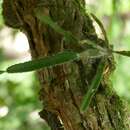pt-BR
nomes no trilho de navegação


Deamia testudo ist eine Pflanzenart in der Gattung Deamia aus der Familie der Kakteengewächse (Cactaceae). Ein spanischer Trivialname ist „Pitaya de Tortuga“.
Deamia testudo wächst epiphytisch oder lithophytisch, kletternd oder hängend mit reich verzweigten Trieben. Die Triebe besitzen auf der Unterseite Luftwurzeln. Sie erreichen Durchmesser von bis zu 8 Zentimetern und sind in bis zu 25 Zentimeter lange Abschnitte gegliedert. Ihre drei bis acht dünnen und flügelartigen Rippen sind oft einseitig angeordnet und zwischen 1 und 3 Zentimeter hoch. Die bis zu 10 (oder mehr) bräunlichen Dornen sind ausgebreitet und 1 bis 2 Zentimeter lang.
Die weißen, weit ausgebreiteten Blüten besitzen oft eine etwas einseitig symmetrische Blütenhülle. Sie sind bis zu 15 Zentimeter lang und erreichen Durchmesser von 15 Zentimetern. Das Perikarpell und die lange Blütenröhre sind mit kleinen Schuppen und braunen 1 bis 3 Zentimeter langen Haaren besetzt. Die gelben, kugelförmigen Früchte sind bedornt und erreichen Durchmesser zwischen 4 und 5 Zentimetern. Das Fruchtfleisch ist weiß.
Deamia testudo ist im Süden Mexikos, in Guatemala, Belize, Honduras, Nicaragua, Costa Rica und Kolumbien verbreitet.
Die Erstbeschreibung als Cereus testudo wurde 1837 von Joseph Gerhard Zuccarini veröffentlicht.[1] Nathaniel Lord Britton und Joseph Nelson Rose stellten die Art 1920 in die von ihnen neu aufgestellte Gattung Deamia.[2] Weitere nomenklatorische Synonyme sind Selenicereus testudo (Karw. ex Zucc.) Buxb. ex Krainz (1965) und Strophocactus testudo (Karw. ex Zucc.) Ralf Bauer (2003).
Deamia testudo ist eine Pflanzenart in der Gattung Deamia aus der Familie der Kakteengewächse (Cactaceae). Ein spanischer Trivialname ist „Pitaya de Tortuga“.
Deamia testudo is a species of flowering plant in the family Cactaceae, native from southern Mexico through Central America to Nicaragua.[1] It was first described in 1838.[2] It is a climber or clamberer, with long stems and large white flowers.
Deamia testudo clambers over or hangs from rocks, or climbs or hangs from trees. It produces roots along its stems by which it clings tightly to its support. The stems are made up of segments up to 25 cm (10 in) long and 8 cm (3 in) in diameter. The stems usually have three ribs, although there may be up to eight. The ribs are thin and wing-like, about 1–3 cm (0.4–1.2 in) high. The areoles have up to 10 or more brownish spines, each 1–2 cm (0.4–0.8 in) long. The flowers have a long thin base and widely spread white tepals. Altogether the flower is about 25 cm (10 in) long and 15 cm (6 in) across.[3][4]
The species was first described by Joseph Gerhard Zuccarini in 1838, as Cereus testudo. Zuccarini ascribed the scientific name to Wilhelm Friedrich Karwinsky.[5] In 1920, Nathaniel Lord Britton and Joseph Nelson Rose considered the species sufficiently distinctive to transfer it to their newly created genus Deamia, where it was the only species.[2] In 1965, Franz Buxbaum transferred it to the genus Selenicereus, based on its flowers, a view supported by Wilhelm Barthlott and David Hunt in 1993. In 2003, Ralf Bauer transferred it to the genus Strophocactus. Meanwhile, in 2002, Alexander Doweld had revived Deamia for both this species and another formerly placed in Selenicereus (Deamia chontalensis).[6] Molecular phylogenetic studies in 2017 and in 2018 confirmed the monophyly of the genus Deamia,[6][7] of which D. testudo is the type species.
Deamia testudo is native from southern Mexico (southeastern, southwestern and Veracruz on the Gulf), through Guatemala, Belize and Honduras to Nicaragua.[1]
Deamia testudo is a species of flowering plant in the family Cactaceae, native from southern Mexico through Central America to Nicaragua. It was first described in 1838. It is a climber or clamberer, with long stems and large white flowers.
Selenicereus testudo (Karw. ex Zucc.) Buxb. es una especie de planta fanerógama de la familia Cactaceae.
Es endémica de Colombia, Panamá, Belice, Costa Rica, Guatemala, Honduras, Nicaragua, y México. Es una especie común en áreas localizadas.
Es una planta perenne carnosa angulada con los tallos armados de espinas, de color verde y con las flores de color blanco.
Selenicereus testudo (Karw. ex Zucc.) Buxb. es una especie de planta fanerógama de la familia Cactaceae.